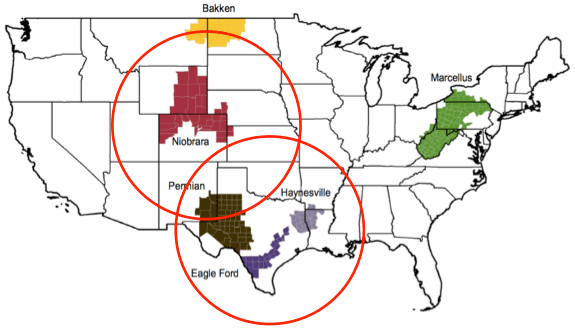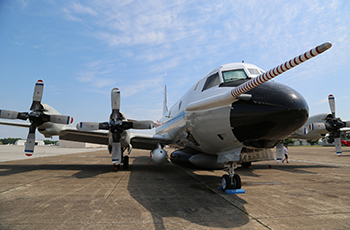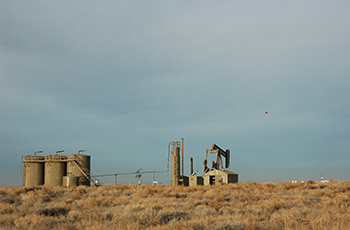A .gov website belongs to an official government organization in the United States.
A lock () or https:// means you've safely connected to the .gov website. Share sensitive information only on official, secure websites.
19 March 2015

NOAA and CIRES lead airborne field campaign to look at climate and air quality impacts.
Vast regions west of the Mississippi River are under development for oil and gas extraction, and the associated equipment has become a familiar sight on any cross-country road trip or flight. But while one focus is on what comes out of the ground, NOAA and CIRES researchers and their colleagues are studying what escapes to the air—and how it is transformed in the atmosphere and affects air quality and climate. The scientists are using a suite of state-of-the-art chemical instruments aboard a research aircraft this spring in the NOAA-led Shale Oil and Natural Gas Nexus (SONGNEX) 2015 field campaign, to study the atmospheric effects of energy production in the western U.S.
Domestic production of oil and natural gas is increasing, as technological advances in directional drilling and hydraulic fracturing (commonly called "fracking") have made the production of oil and natural gas from tight sand and shale formations economically viable. With the increased production comes increased emission of methane, volatile organic compounds (VOCs), and other trace gases to the atmosphere.
The escaped gases have several possible implications, says Joost de Gouw, lead scientist for SONGNEX and a senior scientist at the Cooperative Institute for Research in Environmental Sciences (CIRES), a partnership of NOAA and the University of Colorado Boulder.

"Both climate and air quality are affected by the gases that escape during oil and gas production. And some of them, like methane, affect both issues," said de Gouw, who works in the Chemical Sciences Division (CSD) of the NOAA Earth System Research Laboratory (ESRL) in Boulder, Colorado.
CIRES and NOAA research has shown that many different volatile organic compounds (VOCs) are emitted in the production fields, and that the amount emitted depends greatly on the equipment and production practices in use. The VOCs are key starting ingredients that lead to the production of ozone, a lower-atmosphere pollutant regulated because of its health effects. Other chemical reactions transform the emissions and gases in the air into airborne fine particles, which are also an air quality issue.
Methane emissions are a particular focus because, molecule-for-molecule, it is a more potent greenhouse gas than carbon dioxide. Methane's lower overall abundance in the atmosphere (compared to CO2) leads to its ranking as the second most important greenhouse gas emitted by human activities. Previous NOAA and CIRES work has shown that production activities in some basins emit far more methane than others.

SONGNEX will shed a lot more light on what's going on in the atmosphere above oil and gas production fields, by focusing on basins that represent a mixture of oil and gas production regions at various stages of development. Over a dozen instruments will fly aboard the NOAA WP-3D research aircraft and will sample the air above fields ranging from the Four Corners area and Texas, to Oklahoma, Colorado, Utah, Wyoming, and North Dakota. Flights will be based out of Colorado and Texas beginning in late March and extending throughout the month of April. Colleagues* from universities, industry, and other agencies are joining NOAA and CIRES in the effort.
* Collaborators include Yale University, University of Wisconsin, University of Washington, Harvard University, University of Maryland, Baltimore County. University of Calgary, the National Aeronautics and Space Administration (NASA), Environment Canada, and Aerodyne, Inc.